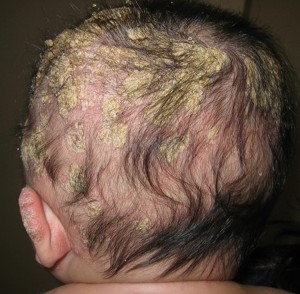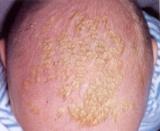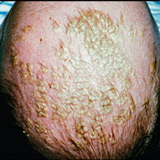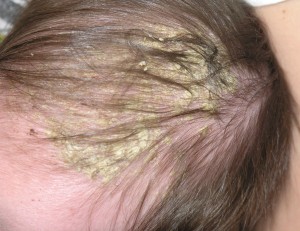Troubled at the sight of the flaky, dry skin in your baby’s Itchy Scalp? It may not be dandruff as you are probably thinking but cradle cap that may actually be at work.
What is Cradle Cap?
Page Contents

Picture 1 – Cradle Cap
Source – eczemacenter
In medical terms, cradle cap is also known as infantile seborrhoeic dermatitis. It is a harmless condition commonly found in babies. In this condition, oily, scale-like rashes are formed on the scalp of a baby. It may also spread to other parts of the body. These are non-itchy rashes and usually do not cause any pain.
Who gets Cradle Cap?
You will normally see Cradle Cap in babies. The disease normally occurs sometime within the first three months after the birth of a baby. The disease is seen in very few older children or adults. But the condition may recur during adolescence and even during adulthood in a few cases. Cradle Cap in toddlers is however, more common.
What causes Cradle Cap?
The exact cause of Cradle cap is still unknown. Factors like poor hygiene or lack of proper baby care have not been established as valid reasons. Infections or allergies are ruled out as possible causes. However, many researchers believe that is a hereditary disease, as the condition is seen to run in families. The disorder is also supposed to affect babies who have a hyperactive sebaceous gland or oil-producing gland. Newborn babies normally still have their mother’s hormones in their circulatory system. If the mother has an overactive oily gland, it may also be present in the baby for a period of time. The glands may bring about Cradle cap.
The disorder is also supposed to be caused by skin yeasts.
Cradle Cap Symptoms
Cradle cap is characterized by a number of symptoms. Most of these are external and visible to the naked eye. These include :
Red rashes
In most cases, Cradle cap is marked by the appearance of red, scaly rashes on the scalp. After a few days, the scales accumulate to form thick, yellow plaques. These look like scabs stuck to the scalp skin. This thick layer may form a covering on the entire scalp.
Seborrheic Dermatitis
In adults, Cradle crap is referred to as Seborrhoeic Dermatitis. It causes bad dandruff and in some cases, a rash, usually on the upper body and the face of sufferers. It mainly affects young adults and peaks at around 40 years of age. It is only rarely that the disorder turns severe; when it does, red rashes may arise on the neck, scalp, chest, face, groins and armpit. Those with conditions compromising the immune system are more susceptible to this disease.
Approximately one out of every 25 adults develops this disorder.
In many cases, the rashes spread to other body areas as well. The affected areas are mainly the oily regions of the skin. Such areas include eyelids, eyebrows, under arms, groin or the skin behind the ears. When the symptoms are seen in other areas as well, he condition is known as Seborrheic Dermatitis and not Cradle cap.
Seborrheic Dermatitis is a chronic skin disease associated with over activity of the sebaceous glands. Sebaceous glands are the oil-producing glands. They are responsible for making the skin oily.
Hair loss
Sometimes, the baby suffers from a loss of hair in the affected region due to the disease.
In most cases, the condition goes away naturally. The thick scaly covering may turn flaky and wear away after a few days. This happens because the sebaceous glands in the baby begin to function normally as it grows older.
However, the condition keeps coming back after some time. If the skin becomes too scratched or swollen, it may possibly lead to a secondary bacterial infection.
How to get rid of Cradle Cap?

Picture 2 – Cradle Cap
Source – baby-medical-questions-and-answers
Parents normally worry how to treat Cradle Cap. This is because the condition looks very abnormal even though it does not cause pain or any physical discomfort to the babies. In mild cases, the condition needs no treatment and it disappears gradually. But immediate cure is necessary if there is a case of severe Cradle Cap. Getting rid of Cradle Cap involves careful treatment. Parents of affected babies may try some home remedies. Getting expert medical treatment would be the best idea if these Cradle Cap treatments fail to work, or if the scales are visible in other areas.
Cradle Cap Treatment (Home Remedies)
Here are some simple tips to cure Cradle Cap in infants and older children. You can try these Cradle Cap remedies for mild cases of the disorder in your baby.
- Massage the affected region with baby oil, Vaseline or vegetable oil. Applying these may help loosen the scales and make them wear away easily after a night or so. Gently washing the area with clean water may help clear the scales. To cure Cradle Cap natural remedy such as these work very well. Do not use shampoos as certain substances inside them may act as irritants and cause damage to the skin. They can also adversely affect the sensitive eyes of the infants.
- Apply a baking soda paste on the affected region of the skin. Wash it away after 10 minutes. Then use soft tooth brushes or bristle brushes to remove the scales. If they do not come away immediately, leave them. Do not prick them or use force. They may come off after a day or two.

Picture 3 – Cradle Cap
Source – getridofthings
- Mild steroid creams or antifungal creams may also work well to remove the scales.
- If Cradle crap is not acute, the flakes arising due to this condition can be gently combed out after bathing. A soft comb or brush can then be used to brush away the softened scales. However, this should be done very gently so as not to worsen the condition and result in temporary loss of hair.
- Over-the-counter dandruff shampoos can reduce the dryness and formation of flakes and fight Cradle Cap in older children. If your baby is aged over six months you can use a seborrhea shampoo to wash the region. Take care that it does not enter the baby’s eyes.
- If there is Cradle Cap on face or around the eyelids, use diluted baby shampoo to cleanse the area. Pour 3-5 drops of baby shampoo into half cup warm water. Use the solution to gently scrub the area. You may also use diluted baking soda solution as a cure. Mix half cup water with a teaspoonful of baking soda and scrub the affected region with the solution. This may help reduce flaking and help the scales naturally wear away.
- If there is redness or inflammation in the affected area, you may use cortisone creams for Cradle Cap cure. These are sold over the counter and easily available for use.
Cradle Cap Medical Treatment
If you suspect your baby to be suffering from Cradle Cap, take him or her to a pediatrician. Doctors usually start treating Cradle Cap after careful observation of the affected area. In some cases, the doctor advises some physical tests to be carried out to rule out other disorders. Professional cure for Cradle Cap generally includes medications and creams.
Apart from an antifungal shampoo or cream, individuals affected by this disorder may also be recommended to use a mild steroid scalp lotion. However, steroids can be harmful for health and due to this reason such lotions should not be used for a long time.
How to prevent Cradle Cap?
It is possible to prevent the occurrence of the disease. Just after your baby is born, wash its hair with light baby shampoo from time to time. Use a soft-bristled brush to form lather around the scalp. Wash the scalp with warm water after some time.
Cradle Cap Pictures
If you have doubts about the scales in the scalp of your infant cradle cap photos are here to help you out. Go through these pictures and know how the disease looks like. This will help you get sure about the condition of your infant.


Picture 4 – Cradle Cap on Dark Skin Picture 5 – Cradle Cap Scalp
Source – mayoclinic Source – jhmi.edu
Cradle Cap is not a very serious disease and fully curable. But it may recur from time to time and bring on severe secondary infections in rare cases. So if you suspect the condition in your baby, treat it immediately at home or get expert medical help. Better still; take steps to prevent the disease. Prevention, as you know, is better than cure.
References:
http://en.wikipedia.org/wiki/Cradle_cap
http://www.babycenter.com/0_cradle-cap_80.bc
http://www.parenttime.com/babytips/cradlecapremedy.html
http://children.webmd.com/tc/cradle-cap-topic-overview
http://www.nhs.uk/conditions/cradle-cap/Pages/Introduction.aspx
http://www.bbc.co.uk/health/physical_health/conditions/cradlecap2.shtml

No Responses